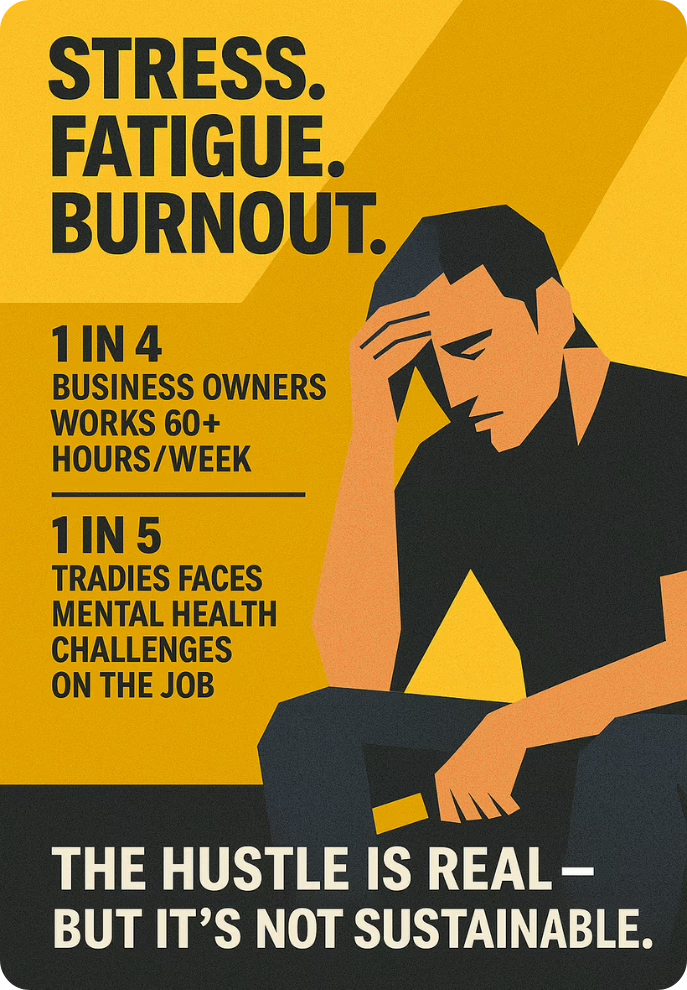The Hidden Cost of Running Your Trade Business Manually
If you’re a contractor or tradie running a small business, you know the grind: days on the tools followed by nights buried in paperwork. On the surface, managing things manually – using pen-and-paper quotes, memory, and ad-hoc spreadsheets – might seem to save money. But hidden beneath are steep costs in lost time, missed opportunities, and mounting stress. This article shines a light on those often-overlooked costs and challenges, and how they impact tradies from Australia to the US. More importantly, we’ll explore how you can turn things around with a bit of smart automation.
The Everyday Struggles of Manual Business Management
Tradies are masters of their craft, whether it’s building, electrical, plumbing, or landscaping. Yet many handle the business side manually, leading to common administrative and operational struggles. Including:
Lost Quotes and Leads: Without a proper tracking system, quotes can get lost in the back of the ute or buried in a notebook. A potential client might be waiting on your bid, but if you misplace their details or forget to follow up, the job could slip through your fingers. Lost quotes mean lost revenue.
Missed Follow-ups: In a busy week, it’s easy to forget to call back a client or send an email you promised. Unfortunately, that silence can come off as unprofessional. A missed follow-up on a big kitchen remodel or plumbing contract could send your client straight to a competitor.
Unpaid Invoices and Cash Flow Chaos: Chasing payments is a job in itself. When invoicing is done sporadically (or not at all), bills fall through the cracks. An unpaid invoice here or there might not seem like much, but over time it chokes your cash flow. (It’s no wonder cash flow issues are cited as a leading cause of small business failures.)
Scheduling Nightmares: Contractor scheduling issues are incredibly common when done manually. Jotting appointments on a calendar (or your hand) can lead to double-bookings or forgotten jobs. Showing up late – or not at all – to a client because of a scheduling mix-up hurts your reputation. And scrambling to rearrange your week at the last minute is wasted, non-billable time.
Paperwork Pile-Ups: Every quote, invoice, receipt, and permit generates paperwork. Without an organised system, you might spend evenings sifting through piles of paper to find that one document you need for tax time or to clarify a client’s query. This is time you’re not getting paid for, and it eats into personal downtime.
These struggles affect every trade. Electricians, plumbers, carpenters, builders, painters – all face similar headaches when running their business manually. And while each issue on its own is an annoyance, together they create a constant drag on your business’s efficiency and your personal sanity.
The Financial Price of Inefficiency
Running a business on sticky notes and memory doesn’t just try your patience – it hits your wallet. Time is money, and hours lost to administrative busywork or sorting out mistakes are hours not spent on income-generating work. In fact, small businesses spend on average 120 working days per year on administrative tasks like bookkeeping, invoicing, and other paperwork1 .
That’s nearly one out of every five working days devoted just to admin, not actual skilled work. For a self-employed tradie or small crew, that hidden time cost is enormous – it’s time that could have been spent completing more jobs or marketing to new clients.
It’s not just the time spent doing admin – it’s also the opportunities lost by not doing it well. For example, forgetting to send out an invoice in a timely manner can delay your payment or even result in not getting paid at all. Late invoicing or poor follow-up means essentially doing work for free until you remember to chase it up. And if you’re slow to follow up on quotes, clients may assume you’re too busy or not interested. They move on, and you lose a job that could have been worth thousands. Multiply those missed jobs over a year, and it can significantly dent your revenue.
Poor organisation also affects cash flow and growth. Consider that close to 50% of small businesses still have no software or formal system in place for critical tasks like accounting and scheduling1 . Many tradies rely purely on manual methods. The result is that they often don’t have a clear view of who owes them money or which jobs are pending, making financial planning a nightmare. It’s a vicious cycle: lack of systems leads to inefficiencies that hurt your income, and lower income leaves you with less resources or time to improve your systems.
To put it bluntly, working harder and longer isn’t the same as working smarter. A day has only so many hours, and if a big chunk of it is being devoured by disorganisation, that’s a hidden financial cost to your business. It quietly eats away at your profit margins. As one report highlighted, if small businesses could claw back just a fraction of the time lost to administration, it would significantly boost their bottom line1 In smaller businesses (like the typical one or two-person trade operation), administrative tasks can consume up to 17% of total manpower1 Think about that – potentially one day per week spent on paperwork and admin instead of earning on the tools. Reducing that inefficiency is like taking a weight off your business’s chest.
The Human Toll: Stress and Trades Burnout
Beyond the dollars and cents, manual business management takes a serious toll on your well-being. It often means long hours, high stress, and little room to breathe. Many tradies start their business for more freedom or to take control of their work life – but end up feeling controlled by the chaos of running the business.
It typically starts with long hours. Nearly 1 in 4 entrepreneurs (including independent tradies) report working more than 60 hours a week2. When you’re spending your daylight hours on job sites and your evenings doing quotes, scheduling, and chasing payments, it’s easy to see how the hours add up. These extended hours might keep the business afloat, but they severely strain your work-life balance. Family time, rest, and personal hobbies get pushed aside.
Unsurprisingly, burnout creeps in. In recent surveys about small business owners, 30% admitted they feel often or constantly burnt out and 64% say they are more stressed than they were just a couple of years ago3. In the trades, this burnout can manifest as chronic fatigue, irritability with customers, or a drop in the quality of work. You might start each morning already exhausted, and it gets harder to face the never-ending to-do list.
Mental health is a critical part of this conversation. The construction and trades industries have been grappling with high rates of stress, depression, and even suicide for years. For example, one in five tradies will experience a mental health condition during their career, and finding ways to cope with that is one of their biggest challenges on the job4 . Long hours and constant pressure are major contributors. When you’re doing everything manually, you’re effectively *always on* – there’s no off switch after 5 PM. Your mind is constantly juggling business tasks: Did I send that quote? Who do I need to call tomorrow? Have I paid the supplier? This mental load can become overwhelming, leading to anxiety and a sense of being drowned in work.
Manual paperwork and disorganisation can lead to serious frustration and stress. It’s not uncommon for hardworking tradies to feel at the end of their rope when juggling a dozen admin tasks in addition to the actual job.
Burnout in the trades doesn’t just affect the business owner – it affects families and clients too. A burnt-out contractor might start making mistakes on site, or they may begin avoiding certain tasks (like answering calls or chasing leads) because they just can’t find the energy. Over time, this can damage the business’s reputation and even personal relationships. It’s tragically common to hear of talented tradespeople who “love the trade, but hate the business”. The passion for the craft gets eroded by the stress of managing everything by hand.
Real-World Consequences When Things Slip Through the Cracks
It’s helpful to visualize how these manual management gaps play out in real life. Here are a few **relatable scenarios** that show the cost of common mistakes:
– The Missed Mega-Job: Imagine a landscaper, Jack, who spent an hour meeting a new client and promised to send a detailed quote for a $10,000 garden makeover. Jack scribbles the details on a pad… which then gets buried on his desk. Two weeks later, by the time he rediscovers it, the client has gone with another contractor. That’s a $10k job lost simply due to a missed follow-up.
– Scheduling Snafu: Tom is a plumber who still uses a paper diary. On a hectic Wednesday, he accidentally schedules two appointments an hour apart on opposite sides of town. There’s no way to make both. He ends up canceling on one client last-minute. Not only is that client angry (and unlikely to call him next time), but Tom also lost the revenue from a job he had booked. Meanwhile, he wasted time and fuel driving under stress to the other site.
– Burning the Candle at Both Ends: Emma runs a small painting business. She’s on the tools from 7 AM to 4 PM, then spends her evenings doing quotes and admin until 10 PM. This goes on for weeks during peak season. Eventually, the long hours catch up – she finds herself constantly exhausted, snapping at clients, and one morning she outright forgets to show up at a scheduled job. She’s hit the burnout wall. Recovering from that (physically and reputation-wise) can take a long time.
Does any of this sound familiar? These scenarios happen to tradies all the time. The costs – a lost high-paying job, a couple unpaid invoices, a client who never calls back, or the toll on your health – pile up quietly. What’s common in each story is that a simple system or reminder could have prevented the pain. This is where the good news comes in: those solutions exist.
A Quiet but Powerful Solution: Automation & Tradie Business Systems
What Can Automations Do?
- Smart Scheduling – Never double book or miss a quote again
- Voice & Text Calls/Confirmation – Call leads and engage them AS SOON as they come in without you even looking at your phone
- Centralise Data and Assets
Thankfully, the same technology that’s changed so much of our daily lives has an answer here. Embracing automation and tradie business systems is like having a silent partner in the background, handling the admin and keeping your operations on track. It doesn’t mean turning your business into a high-tech enterprise or losing the personal touch your clients love. Rather, it means offloading the routine, repetitive stuff to tools that can do them faster (and often better) than we can manually.
How We Use AI
- Deep Personalisation Cold Outreach System
- An automated AI-driven system for highly personalised outreach at scale. Uses publicly available data (LinkedIn, company websites, etc.) to deeply personalise messages. Combines scraping, AI-generated personalisation, and automatic email sending. Significantly boosts reply rates (often 20-40% improvement).
- AI-Powered Invoice & Payment Automation
- Automates invoice creation, sending, follow-ups, and payment tracking. Uses AI to detect overdue payments and trigger personalised follow-up messages. Integrates seamlessly with common accounting software (QuickBooks, Xero, etc.). Significantly reduces late payments and unpaid invoices.
- CRM Automation
- This is where ideas become infrastructure. We design and build your automation systems, workflows, and operational dashboards — then stress-test them across your actual business scenarios. Our team handles the tech and integrations, while training your team to use everything with clarity and ease. You’ll walk away with systems that run — and last.
- Proposal & Document Generation Automation
- Once your foundation is built, we shift gears toward sustainable scaling. With regular reviews, optimisations, and growth sprints, we help you refine what’s working and unlock what’s next. Whether it’s expanding your offer, increasing lead flow, or leveling up your team — your systems are ready for it. And so are you.
- Onboarding & Client Intake Automation
- Automates the client onboarding process after a deal is closed. Collects client info via smart forms, stores it in a central system, and triggers welcome emails, access provisioning, and kickoff. Integrates with project management tools and RMs for a smooth handoff. Creates a consistent, professional onboarding experience.
- Customer Support Ticketing Automation
- Automates intake, triage, and routing of customer support tickets. Uses AI to categorise issues and assign priority levels. Creates tasks or alerts in support tools (e.g., HelpScout, Zendesk, ClickUp). Reduces response time by instantly routing tickets to the right person or department.
- Recruiting & Candidate Screening Automation
- Automates job application intake, candidate pre-screening, and interview scheduling. Uses AI to rank applicants based on resume content or form responses. Pushes top candidates into ATS or team dashboards with relevant data. Saves hours in manual resume review and filtering.
- Sales Pipeline & Follow-Up Automation
- Automates the movement of deals through a sales pipeline based on activity or time. Sends follow-up emails, reminders, and status updates based on lead behaviour. Updates RM stages automatically to reflect deal progress. Prevents leads from falling through the cracks.
- Internal Reporting & Analytics Automation
- Automates generation of weekly/monthly reports using data from multiple sources (CRM, Stripe, Google Sheets, project tools) Formats and delivers visual dashboards or summaries to stakeholders. Can include key KPIs, project status, sales data, and customer feedback. Saves time spent pulling data manually across platforms.
- Custom Solutions
- No two businesses operate the same — so why use cookie-cutter tools? Our AI systems are built to fit your workflows, not the other way around. Whether it’s automating lead qualification, streamlining team communication, or building intelligent follow-up sequences, we design AI-powered solutions tailored to your operations. The result? Less time spent on repetitive tasks, and more energy focused on growth.
From Chaos to Control: Reclaiming Your Time and Sanity
The hidden costs of running your business manually – the lost income, the long hours, the stress – don’t have to be a permanent part of your life. Contractors across Australia, the US, and beyond are discovering that a little bit of organisation and automation goes a long way. By addressing the inefficiencies, you’re not just saving money; you’re buying back time – hours in your week that can be spent earning more or enjoying a well-deserved break.
The shift doesn’t have to be overwhelming. You can start small: maybe begin by using a digital invoicing tool or a scheduling app on your phone. Many tradie-friendly business systems (like the one mentioned above) are designed for people who aren’t tech gurus – they’re as easy as using a smartphone. Over time, you can build on your system, adding templates for common quotes, setting up automatic follow-up emails, or integrating a voice assistant for hands-free updates. Each little step toward automation is a step away from the chaos of manual management.
The bottom line is that running your trade business does not need to feel like running on a hamster wheel. The hidden costs – both financial and mental – of doing it all by hand can be tackled. When you invest in better systems, you’re investing in yourself and your business’s future. Fewer mistakes happen, fewer balls get dropped, and you can deliver an even more professional service to your customers.
In the end, the goal is simple: less busy-work, less burnout, and more time doing what you do best. By choosing to streamline and automate parts of your tradie business, you transform those piled-up papers and mental to-do lists into smooth, automated flows. It’s like finally fixing a leaky pipe in your own operation – once it’s done, you wonder why you put it off so long. Take the leap to organise and automate, and watch as the hidden costs of running your business manually begin to fade, allowing your business to truly build and bloom.
Sources
([1,2](https://www.cpapracticeadvisor.com/2017/09/13/smbs-spend-120-working-days-per-year-on-admin-tasks-and-bookkeeping/27084/#:~:text=Small%20businesses%20currently%20spend%20an,maker%20of%20cloud%20accounting%20software))
([3](https://www.bankatfirst.com/business/resources/flourish/small-business-lending solutions.html#:~:text=We%20get%20it%2C%20owning%20a,159)).
([4](https://steelblue.com/au/mental-health-tools-of-the-trade/#:~:text=For%20one%20in%20five%20tradies%2C,condition%20they%20will%20inevitably%20experience)).
Book A Free Call Where We:
Understand Your Business: A quick conversation about your current systems, bottlenecks, and goals. No complicated jargon — just a clear understanding of what’s slowing you down.
Identify High-Impact Automation Opportunities: We’ll map out at least 3-5 areas where AI-driven systems could save you time, increase leads, or reduce manual work.
Show You Real Examples: We’ll share a few examples of automations we’ve built for businesses like yours — so you can see the possibilities (even if we don’t work together).
Deliver Your Custom AI Systems Map: You’ll walk away with a free, no-strings-attached map showing how we’d systemise key parts of your business.
We only build 3–4 systems per month to protect client quality. If you want priority access, book your Systems Audit within 48 hours.
Whether you’re a tradie, clinic owner, agency, or e-commerce brand — custom-built AI automations can save you time, boost your sales, and eliminate bottlenecks.
Let’s build a system that scales with you.
Business Consulting | Growth Systems | AI Integration | Restructure | NDIS Audits | Strategic Planning | The Lead Compounding OS




Leave a Reply